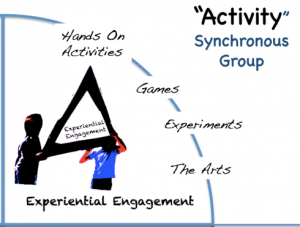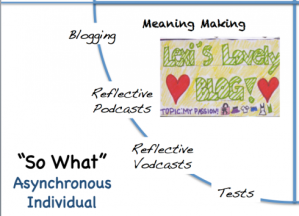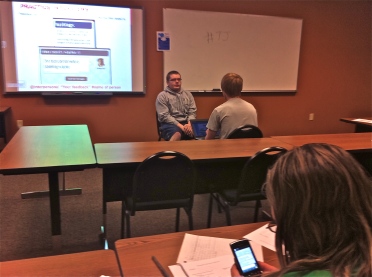Flipped Classroom Full Picture: An Example Lesson
The flipped classroom, as it is currently being described and publicized, is simply recording the didactic content information via videos, having students view these as homework, and then using class time to further discuss these ideas.
Harvard Professor Chris Dede stated in his Global Education 2011 keynote in response to a question directed about the flipped classroom . . .
I think that the flipped classroom is an interesting idea if you want to do learning that is largely based on presentation. You use presentation outside of the classroom. Then you do your understanding of the presentation and further steps from the presentation inside the classroom. I think it is a step forward. It is still, in my mind, the old person. It’s still starting with presentational learning and then trying to sprinkle some learning-by-doing on top of it. I am interested more in moving beyond the flipped classroom to learning by doing at the center than a kind of the intermediate step that still centers on largely on tacit assimilation.
As I describe in The Flipped Classroom: The Full Picture, I believe, as Chris Dede does, that the problem with the flipped classroom is that the major focus is on the didactic presentation of information, that it is still at the center of the learning experience. The flipped classroom, given that is currently getting so much press, provides an opportunity to change the paradigm of learning, whereby learning–by-doing, the experiences along with the understanding and application of those experiences become core to the learning process.
The following lesson describes a type of flipped classroom. This lesson did not center around the content media, in this case the Slideshare, but on the students’ personal experiences, interactions with other students, and acquisition of tangible life skills.
Interpersonal Communications: Listening Skills
Experiential Engagement: The Activity
The cycle often begins with an experiential exercise. This is an authentic, often hands-on learning activity that fully engages the student. It is a concrete experience that calls for attention by most, if not all, the senses. They become hooked through personal connection to the experience and desire to create meaning for and about that experience (ala constructivist learning).
For this lesson, the learners started off with the Lighthouse activity, where in partner teams, the sited person led his or her blindfolded partner through a series of obstacles. The goal of this part of the lesson was to provide an experience that overtly demonstrated the importance of listening – especially when the sense of sight is taken away.
Conceptual Connections: The What
Learners are exposed to and learn concepts touched upon during Experiential Engagement. They explore what the experts have to say about the topic. Information is presented via video lecture, content-rich websites and simulations like PHET and/or online text/readings. In the case of the flipped classroom as it is being currently discussed, this is the time in the learning cycle when the learners view content-rich videos. The videos support the experiential learning rather than being at the center of the learning experience.
In this lesson, the learners were asked to view and review the following slideshare via their own computer terminals.
The benefit of this form of personalized viewing is that the learners have control of the media so they can view it at their own pace – spending more time on the concepts they need to further review or of which have special, personal interest. Use of their own computers also permit them to search for more information about a given topic.
Meaning Making: The So What
Learners reflect on their understanding of what was discovered during the previous phases. It is a phase of deep reflection on what was experienced during the first phase and what was learned via the experts during the second phase. Learners can articulate and construct their understanding of the content or topic being covered through written blogs or verbal-based audio or video recordings.
For this lesson, the learners made a personal connection with the content as they were asked to identify the 10 listening skills they believed they needed to further develop. This also became a technology-enhanced lesson. Learners made a mind map of their identified 10 skills that included: (1) the skill, (2) normal and current behaviors associated with the skill, and (3) goals and steps for improvement.
Demonstration and Application: The Now What
During this phase, learners get to demonstrate what they learned and apply the material in a way that makes sense to them. This goes beyond reflection and personal understanding in that learners have to create something that is individualized and extends beyond the lesson with applicability to the learners’ everyday lives. This is in line with the highest level of learning within Bloom’s Revised Taxonomy of Learning – Creating – whereby the learner creates a new product or point of view. In essence, they become the storytellers of their learning (See Narratives in the 21st Century: Narratives in Search of Contexts). A list of technology-enhanced ideas/options for the celebration of learning can be found at: https://usergeneratededucation.wordpress.com/2010/09/09/a-technology-enhanced-celebration-of-learning/
The learners practiced their active listening skills during class time. Feedback was provided to the listener via their mobile devices using Celly. See the full description at Students’ Own Mobile Devices and Celly Provide Peer Feedback.
Part Two
The learners located a professional in their area of study to interview. Their interview questions focused on the communication skills expected of those in that profession. Their homework was driven by real-life experiences going out to speak with a professional in their communities. The professional was asked to complete an evaluation of the student’s performance during the interview. Homework was designed to further promote the applicability, transferability, and relevancy of this lesson.














Thank you for sharing this. I teach science at the 6th grade level. I would love to read more
about how you are implementing the flipped concept. I have not found anyone sharing this in this way Thank you. Please add me to your page or send me a link. Thank you.
Jim
Jim rowley
November 21, 2011 at 5:48 am
[…] Flipped Classroom Full Picture: An Example Lesson (usergeneratededucation.wordpress.com) […]
Presenting the Experiential Learning Cycle | Throwing Back Tokens
November 21, 2011 at 2:29 pm
[…] Having done a wee bit more research around the Flipped classroom that centre around videos, I found this rather thought-provoking blog post by Jackie Gerstein entitled Flipped classroom full picture: An example lesson […]
Untangling notions of flipped classrooms | ICT Enhanced Learning and Teaching's Blog
February 7, 2012 at 12:55 am
Thanks, Hazel!
Jackie Gerstein, Ed.D.
February 7, 2012 at 2:17 am
Great post! This really makes sense to me. I’m in my 3rd year of teacher training, and I’ve heard about but not seen a flipped classroom. It sounded innovative but it seems that it’s just repackaging the same educational philosophy we’ve been using for a while. Are there people out there teaching (hopefully at secondary level) using a “true” flipped approach?
Murray Jarman
February 8, 2012 at 1:38 am
Thank you Hazel. I strongly agree with your initial statements about tutorials at home and the limitations that this style of learning brings. In the Early Years teaching environment we are very much in tune with the “Learning by Doing” style without the additional tutorials at home. I agree that if education is experiential, interactive and collaborative then the learning outcomes are not only more fully understood at the time of learning; but also have far better longevity in their retention. Future learning can then readily draw upon the the previous experiential learning.
Robyn Lack
December 10, 2012 at 7:17 am